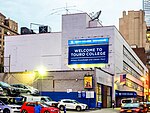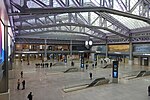Moynihan Train Hall

Moynihan Train Hall is an expansion of Pennsylvania Station, the main intercity and commuter rail station in New York City, into the city's former main post office building, the James A. Farley Building. Located between Eighth Avenue, Ninth Avenue, 31st Street, and 33rd Street in Midtown Manhattan, the annex provides new access to most of Penn Station's platforms for Amtrak and Long Island Rail Road passengers, serving 17 of the station's 21 tracks. The hall is named after Daniel Patrick Moynihan, the U.S. Senator who had originally championed the plan. The building's exterior resembles that of the original Penn Station; both buildings were designed by the same architect, McKim, Mead & White, in the Beaux-Arts style. The 486,000 sq ft (45,200 m2) complex was built to alleviate congestion in Penn Station, which saw 650,000 daily riders before the COVID-19 pandemic in 2020. The $1.6 billion renovation restored the Beaux-Arts Farley Building, a designated landmark, and added a central atrium with a glass roof. Moynihan Train Hall includes retail space, a 320-seat waiting area, and public restrooms. The hall is decorated with three artworks: a ceiling triptych named Go, a group of photographic panels, and a sculptural group. The project had been in consideration since the early 1990s, with the first blueprints made public in 1993. However, several previous plans had failed because of a lack of funding and logistical difficulties. Amtrak withdrew as a tenant in 2004, but returned after the Farley Building was sold to the New York state government in 2006. A first phase, involving an expansion of a concourse under the Farley Building, started in 2010 and was completed in June 2017. Construction of the train hall proper commenced in 2017, and it opened January 1, 2021.
Excerpt from the Wikipedia article Moynihan Train Hall (License: CC BY-SA 3.0, Authors, Images).Moynihan Train Hall
8th Avenue, New York Manhattan
Geographical coordinates (GPS) Address Nearby Places Show on map
Geographical coordinates (GPS)
| Latitude | Longitude |
|---|---|
| N 40.751111111111 ° | E -73.995277777778 ° |
Address
James A. Farley Building
8th Avenue 421
10199 New York, Manhattan
New York, United States
Open on Google Maps







